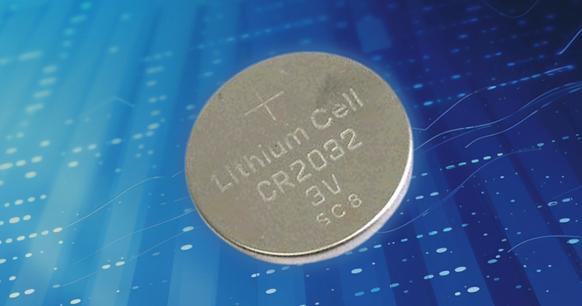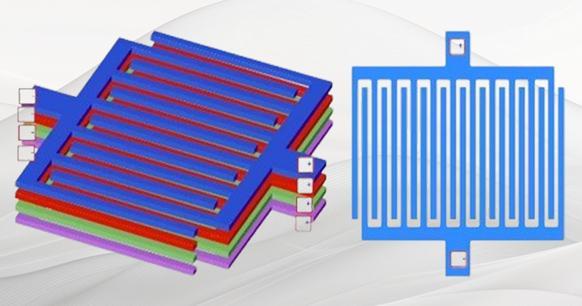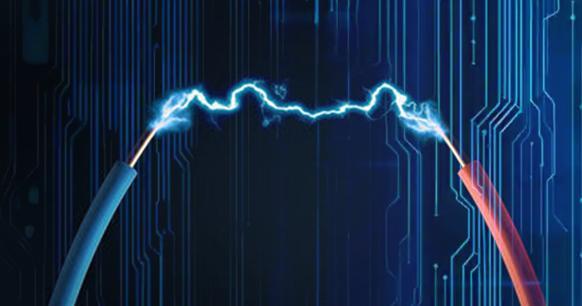
Understanding Coaxial Cables: Types, Uses, and Key Features
What is Coaxial Cable?
A coaxial cable is a type of wire that transmits signals. It is comprised of four layers of materials: the innermost line is a conductive copper wire, and the outside of the line is surrounded by a layer of plastic (for insulator and dielectric purposes). There is a thin layer of net-like conductors outside the insulator (usually copper or alloy). The outermost insulating material is the outer skin of the cable.

Coaxial Cable
Coaxial lines are suitable for both analog and digital communications. They are used for a variety of purposes, the most common of which are television broadcasting, long-distance phone transmission, short-distance computer system connections, and local area networks. Coaxial cable has become a popular choice for distributing television signals to thousands of homes. A coaxial cable for TV systems can carry dozens, if not hundreds, of TV channels, with a transmission range of tens of kilometers. Long-distance telephone networks have relied on coaxial cable for years. However, fiber optics, terrestrial microwaves, and satellites are all posing rising competition today.
What are the main types of coaxial cable?
There are two primary types of coaxial cable: baseband and broadband.
Baseband coaxial cable
The baseband coaxial cable's shielding layer is commonly a copper mesh structure with a characteristic impedance of 50. The most common versions are RG-8 (thick cable) and RG-58 (thin cable) for transmitting digital signals (thin cable). The diameter of a thick cable vs. a thin cable is the most obvious distinction. Thick cable is ideal for medium-sized local networks. It has a vast standard range and a high level of dependability. However, the thick cable network requires transceivers and transceiver cables, which are both difficult to install, resulting in a high overall cost. The skinny cable, on the other hand, is simpler and less expensive. During the installation, however, the cable must be cut. As a result, when there are a lot of joints, it's easy to make bad contact.
Broadband Coaxial Cable
In most cases, the shielding layer of broadband coaxial cable is made of aluminum. It has a 75-ohm characteristic impedance. Analog communications are typically sent using this type of connection. The RG-59 is the most widely used model. It's a type of transmission cable that's commonly used in cable television networks.
Broadband coaxial cable can simultaneously broadcast numerous channels of TV signals over a single cable. Some computer networks can also use this transmission method.
What is a coaxial cable?
There are two coaxial conductors in a coaxial cable: one is the inner conductor and the other is the outer conductor. Their roles can be imagined as follows: one is the data transmission path, and the other is the data transmission loop. As shown below:
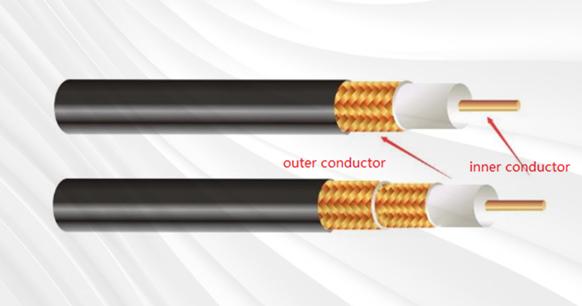
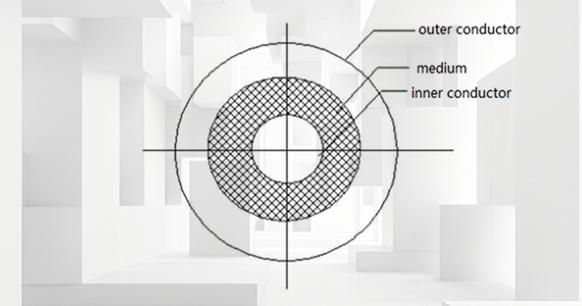
The inner and outer conductors comprise the coaxial wire. The two conductors are arranged coaxially, with the transmission signal confined to the outer conductor. The outer conductor is a shielded transmission line, ensuring good shielding performance, low transmission loss, and strong anti-interference. It is frequently used for the transmission of higher frequency signals. For common coaxial cables with copper conductors, the insulating material is typically Teflon or polyvinyl chloride.
How do coaxial cables work?
Four layers form the coaxial cable, starting from the inside and moving outwards: the central copper wire (either a single-strand solid wire or multi-stranded wire), the plastic insulator, the mesh conductive layer, and the wire sheath. The central copper wire and the mesh conductive layer form a current loop. The coaxial interaction between the center copper wire and the meshed conductive layer is what gives the cable its name.
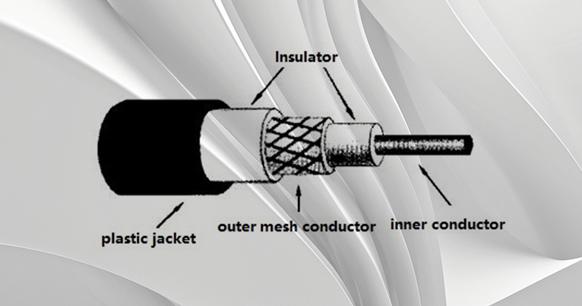
Coaxial Cable Material
Instead of conducting direct current, coaxial cables conduct alternating current, which means the current's direction is reversed multiple times every second.
The signal's power is lost, and the received signal's strength is reduced as a result of this consequence.
The coaxial cable can solve this problem. The radio emitted by the central wire is isolated by the mesh conductive layer, which can be grounded to control the emitted radio.
If a section of the cable is squeezed or twisted, the distance between the center wire and the mesh conductive layer is not consistent, which affects the internal radio waves. This causes the internal radio waves to be reflected back to the source of the signal, reducing the receivable signal power. To address this issue, a layer of plastic insulator is added between the center wire and the mesh conductive layer to ensure consistent distance between them. This also results in a relatively stiff and inflexible cable.
The outside conductor of a coaxial cable has been significantly enhanced by the shielding material. It has evolved from a tubular outer conductor to a single-layer braided and double-layered metal. While the tubular outer conductor offers excellent shielding properties, it is difficult to bend and utilize. The shielding efficiency of single-layer braiding is the lowest, and the transfer impedance of double-layer braiding is three times lower than that of one-layer braiding. It is evident that the shielding effect of double-layer braiding has been significantly enhanced compared to single-layer braiding. Major coaxial cable manufacturers are continuously enhancing the outer conductor structure of the cable to ensure optimal performance.
Coaxial Cable Advantages and Disadvantages There is still plenty of room for improvement. The second disadvantage is that it is unable to endure tangles, pressures, or abrupt bends, all of which can destroy the cable structure and inhibit signal transmission. Finally, there is the expensive expense, but twisted pair can overcome all of these drawbacks.
What is the difference between the coaxial cable and ordinary cable?
There are different types of materials used in the production of coaxial cables. These include copper conductors separated by insulating materials. The constituent materials of ordinary cables are several wires or groups of wires. Coaxial cables are divided into two categories: baseband and broadband. There are also two types of ordinary cables: DC and AC. Finally, coaxial cables are available in two different types: thin cable RG-58 and thick cable RG-11.
Ordinary cables are classified into several categories, including flame-retardant rubber sheathed cables, nuclear-grade cables, bare wires, and bare conductor products. Additionally, they are divided into power cables, communication cables, and optical fibers, electromagnetic wires, and flexible fire-resistant cables.
Parameter Index of Coaxial Cable
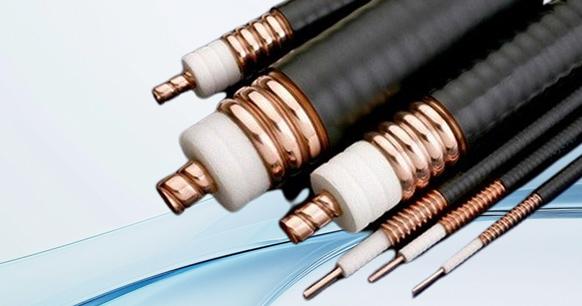
Electrical Parameters
(1) The characteristic impedance of the coaxial cable: the average characteristic impedance of the coaxial cable is 50±2Ω. The periodic change of the impedance along a single coaxial cable is a sine wave. The center average value is ±3Ω, and its length is less than 2 meters.
(2) Coaxial cable attenuation: It refers to the attenuation value of a 500-meter cable length in general. The value does not exceed 8.5 dB (17 dB/km) when measured with a 10 MHz sine wave, and it does not exceed 6.0 dB (12 dB/km) when measured with a 5 MHz sine wave.
(3) The propagation speed of the coaxial cable: The minimum propagation speed required is 0.77 C (C is the speed of light).
(4) Coaxial Cable DC Loop Resistance: The sum of the resistance of the center conductor of the cable and the resistance of the shielding layer does not exceed 10 milliohms/m (measured at 20°C).
Physical Parameter: A coaxial cable is composed of a central conductor, an insulating material layer, a shielding layer composed of mesh fabric, and an outer isolation material layer.
The coaxial cable is flexible enough to support a bending radius of 254mm (10 inches). The center conductor is a solid copper wire with a diameter of 2.17mm±0.013mm. The insulating material must meet the coaxial cable's electrical characteristics. The shielding layer is comprised of a metal strip or sheet that meets the transmission impedance and ECM criteria. The inner diameter of the shielding layer is 6.15mm, while the outer diameter is 8.28mm. PVC or related polymers are commonly used for external insulation.
What are the characteristics of different dielectric materials of coaxial cable?
As with other cables, coaxial cables have different wire diameters and core diameters, conductor and insulation materials, and cable sheath materials. The combination of these parameters determines the electrical performance, mechanical performance, and environmental adaptability of the coaxial cable.
Impact on cable delay and propagation speed.
The dielectric insulator (dielectric) in the cable is the main factor that affects the delay and propagation speed of the cable. The dielectric materials include solid polyethylene (PE), polyethylene foam (FE/PF), air-insulated polyethylene (ASP), foamed polystyrene (FS), solid Teflon/solid polytetrafluoroethylene (ST/SPTFE), air-insulated Teflon (AST), and others. The following table summarizes the influence of various materials on cable delay and propagation speed.
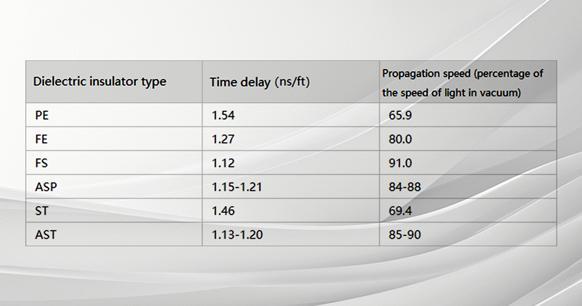
The applicable working temperature of the insulating medium and outer skin
This determines the applicable environment of the selected cable. Please refer to the following table for further information.
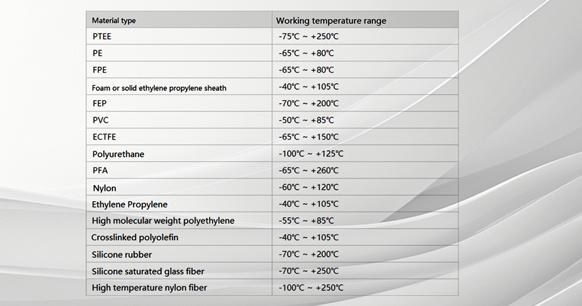
Cable Sheath Material
1. When wrapping a cable around an object for connection, the cable sheath should be a highly flexible thermoplastic rubber (TPR). However, it is important to note that continuous movement of the cable with this sheath may affect performance.
2) For cables used in elevators that require flame retardancy, special upright cables (CMR) must be used instead of polyethylene materials. The cable sheath can prevent the spread of flames to unfired areas.
3) For cables in the hidden space of the horizontal path in the building, the mezzanine cable (CMP) bundled by Teflon outside is an effective solution to prevent the cables from kinking together and to ensure low toxicity when on fire.
4) If you need to route cables outside the building or along with the ceiling of the office, PVC or TPR cable skins are a suitable option to increase flexibility without increasing insertion loss.
5) The sandwich cable with fluorinated ethylene propylene (FEP) material offers low loss and high-temperature resistance.


